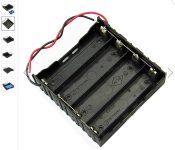Hello,
I'm new to DIY batteries, and am particularly interested in no-weld techniques. The obvious reason would be that I don't have expensive spot welding tools, and that I'm a strong believer in recycling. Now how about using 10-13 of those cheapo 4-cell-holder in series (see attached file)
I guess some of you must have tried it, and there is a reason no one uses them to build ebike battery packs. So I would love to read those reasons. Only real drawback I could think of is stability: the cells probably don't hold very well in those. But perhaps using thin foam between the racks would increase stability to a point where they are safe to use ?
I'm new to DIY batteries, and am particularly interested in no-weld techniques. The obvious reason would be that I don't have expensive spot welding tools, and that I'm a strong believer in recycling. Now how about using 10-13 of those cheapo 4-cell-holder in series (see attached file)
I guess some of you must have tried it, and there is a reason no one uses them to build ebike battery packs. So I would love to read those reasons. Only real drawback I could think of is stability: the cells probably don't hold very well in those. But perhaps using thin foam between the racks would increase stability to a point where they are safe to use ?


